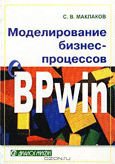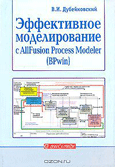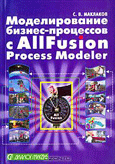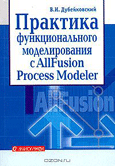BPwin is a software product developed by ltd. Logic Works Company. It is designed to support the process of creating information systems. It belongs to the category of upper-level CASE tools. The first version of BPwin was released in 1995 together with another CASE tool - ERwin that was designed for data modeling. Platinum Technology was engaged in the development and maintenance of BPwin in the future and the latest versions were developed by CA Technologies.
BPwin
BPwin is a well-developed modeling tool that allows you to analyze, document and improve business processes. You can simulate actions in processes, determine their order and the necessary resources with its help. BPwin models create the structure that necessary for understanding business processes, identifying control events and the order of interaction of process elements among themselves.
BPwin supports functional modeling, workflow modeling, and data flow. The corresponding diagrams are implemented based on the IDEF0, IDEF3 and DFD standards. Functional modeling makes it possible to carry out a systematic analysis of business processes with pay attention to regularly performed tasks (functions). Work flow modeling provides analysis of the process execution logic. Data flow modeling allows you to focus on data exchange between different tasks. You can create as separate models as mixed models in BPwin.
BPwin provides detailing in order to complex analyze the work of an organization and to build large models. Models can be divided into groups. Each model is presented at a lower level of detail. The relationship between the models and their elements is preserved at the same time. The model can be divided into component parts, and then you can work separately with each of them, and then integrated back into a single model.
BPwin allows you to create the following types of models:
- functional diagrams. They are based on the IDEF0 standard. These diagrams are divided into four types:
The first type is a context diagram. It represents a description of the process at the very top level. This diagram gives an overview of the process and its relationship with the external environment or other processes;
The second type is the decomposition diagram. It details the information of the context diagram;
The third type is a host tree diagram. This diagram is designed to display a hierarchy of functions;
The fourth type is a description diagram. It is used to represent individual parts of the process. It can be used to take various descriptions that are not supported by the IDEF0 standard.
- Flow Chart Diagrams (FCD). They are based on the IDEF3 standard. These diagrams make it possible to show the logic of the process by presenting tasks in a certain sequence. These models can be used as a basis for creating dynamic models in the future.
- Data Flow Diagrams (DFD). These diagrams show how information moves from task to task within the process. The DFD model represents the physical characteristics of an information system, because it shows the movement of information objects and data storage.
- Cost Analysis Models. These models are created according to the rules of cost analysis (Activity Based Costing analysis). A model can be built only if a fully complete and noncontradictory functional model already exists. Metrics are assigned to each of the functional model's tasks. Cost centers are defined for the model. A cost analysis model is as result.
- Dynamic Models. These models can be created based on work flow diagrams. BPwin allows you to study the effects during a discrete change in the state of the tasks of the process. Various scenarios of the process action can be set to do this. It is necessary to export diagrams based on IDEF3 to a special software product – business process simulator (for BPwin 4.0) or Arena (for BPwin 7) in order to perform dynamic modeling.
All these models were implemented in BPwin 4.0 which has become the most popular in the series of these products. The latest version was BPwin 7, which was called ERwin process modeler and was part of the ERwin Modeling Suite.
BPwin capabilities
BPwin's capabilities make this product convenient and effective CASE tool. The main functional capabilities of BPwin, important from the point of view of business process modeling, include the following:
- the modeling based on several standards. The possibility of modeling based on the IDEF0, IDEF3 and DFD standards allow you to take a detailed and comprehensive analysis of business processes;
- the simulation modeling. BPwin makes it possible to trace the change in business processes in dynamics due to the exporting models;
- documentary support of models. It is possible to organize the connection of models with process documents (for example, with instructions, regulations, etc.) and open these documents directly from the modeling environment due to the built-in tools in BPwin;
- integration of process models and data models. This allows you to organize a single repository for models and the objects that make up these models.
BPwin advantages
Model development requires a clear understanding of all aspects of business processes. The CASE tool should allow you to model the actions of the process, the order of their execution and control, the composition of resources and information, the composition of inputs and outputs of processes, and also make it possible to document the obtained results. BPwin 7 performs all these tasks to one degree or another.
BPwin 7 has the following advantages in comparison with other CASE tools of this level:
- simple graphical interface. The BPwin 7 interface is easy to understand. It allows you to make customizations for the user that simplifies the modeling process;
- presentation of additional information. It is possible to collect additional information on processes, present it in models and include it in reports due to the use of UDP properties (user-define properties). Reports can be submitted in publicly formats like Microsoft Word or Microsoft Excel;
- checking the models correctness. BPwin 7 monitors incorrect connections and representations of model elements due to the built-in tools. This improves the quality of models and increases integration with other modeling tools;
- built-in report generator. You can create a template for the required report and apply this template to any BPwin 7 models with this generator. Reports can be submitted in HTML, RTF, TXT, PDF formats.
BPwin Books
Very little books on the BPwin software product are being released now. This CASE tool is losing its position and support for the product is discontinued. There is still some popular and useful literature on working with BPwin, as well as the development of this software in AllFusion Process Modeler.

Business process modeling with BPwin 4.0
The book was released in 2002. This book includes work specification of the most popular BPwin 4.0. version. It contains a description of the modeling methodology that is used for BPwin (IDEF0, DFD, IDEF3 methods), a description of the BPwin software product and its capabilities, methods for building reports using BPwin, explains the construction of a data model, and provides examples of using BPwin and Erwin for modeling business processes. The book provides exercises for creating a functional model of the company's activities.
The book is intended for business analysts and specialists involved in business process modeling.

Efficient modeling with AllFusion Process Modeler
This book was released in 2007 and presents a description of the work in the modeling package AllFusion Process Modeler version 4.1.4 and All Fusion PM. The book describes the methodologies of functional modeling IDEF0, IDEF3 and data modeling DFD. The detailed application of the AllFusion package for modeling purposes is given. The solved tasks by using this package are indicated. Examples of effective use of AllFusion in various fields are given.
The book will be useful for system and business analysts, as well as anyone interested in modeling and analyzing business processes.

Business Process Modeling with AllFusion Process Modeler
This book provides a description and procedure for working with the modeling package AllFusion Process Modeler 4.1. The book is an updated edition of the previous edition. The book consists of 5 chapters. The first chapter describes the BPwin 4.1 tools, the creation of models in IDEF0, IDEF3, DFD notations, the procedure for conducting cost analysis. The second chapter describes the procedure for creating reports using AllFusion Process Modeler 4.1 tools. The third chapter is devoted to the issues of linking the process model and data models. The fourth chapter discusses the issue of group model development in AllFusion Process Modeler 4.1. The fourth chapter contains 16 exercises on creating process models for independent work of readers.

Practice functional modeling with AllFusion Process Modeler 4.1. Where? What for? How?
This is an earlier version of the book "Effective Modeling with AllFusion Process Modeler". It was released in 2004. The content of the book includes modeling questions on IDEF0, DFD, and IDEF3 notations. The description of the AllFusion Process Modeler 4.1 package is given. There is an application for the purposes of developing business process models.
The book can be useful to specialists that dealing with the reorganization of business processes, modeling of enterprises, business analysts, functional modeling specialists and IT specialists.
